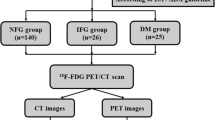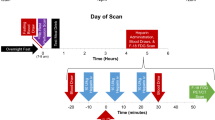Abstract
Objective
Positron emission tomography (PET) with fluorodeoxyglucose (FDG) is widely used for evaluation of cancer and ischemic heart disease. Recently, increased myocardial FDG uptake has been reported to be related to some types of heart disease, such as sarcoidosis. However, the physiological increased FDG uptake in the heart often mimics the abnormal high uptake in these cases. In this study, we investigated the relationships between myocardial uptake and age, blood glucose level, fasting period, and hospitalization status (inpatient vs. outpatient).
Methods
A total of 159 non-diabetic patients were enrolled in the present study. Patients were imaged on a PET/CT scanner, and a three-dimensional region of interest (ROI) was drawn on the fused PET/CT image to measure the maximum standardized uptake value (SUVmax) of the whole left ventricle.Results: No significant relationships were observed between myocardial uptake and age or fasting period. Blood glucose level showed a significant relationship (p = 0.025) with myocardial uptake, but the R-square was extremely small (r2 = 0.03). With an SUVmax threshold of 3.0, there was no significant difference between inpatients and outpatients. However, outpatients showed a significantly higher frequency of myocardial uptake over SUVmax of 5.0 (x 2 test: p = 0.046).
Conclusion
It is difficult to predict the degree of physiological uptake in the heart from data regarding age, fasting period, or blood glucose level. Outpatients tend to show higher myocardial uptake than inpatients, which may make it difficult to detect abnormally increased uptake in the heart. A long fasting period, such as overnight fasting, is an inadequate means to reduce the physiological uptake of FDG in the heart.
Similar content being viewed by others
References
Tillisch J, Brunken R, Marshall R, Schwaiger M, Mandelkern M, Phelps M, et al. Reversibility of cardiac wall-motion abnormalities predicted by positron tomography.N Engl J Med 1986; 314: 884–888.
Haas F, Haehnel CJ, Picker W, Nekolla S, Martinoff S, Meisner H, et al. Preoperative positron emission tomographic viability assessment and perioperative and postoperative risk in patients with advanced ischemic heart disease.J Am Coll Cardiol 1997; 30: 1693–1700.
Landoni C, Lucignani G, Paolini G, Zuccari M, Galli L, Di Credico G, et al. Assessment of CABG-related risk in patients with CAD and LVD. Contribution of PET with [18F]FDG to the assessment of myocardial viability.J Cardiovasc Surg (Torino) 1999; 40: 363–372.
Yamagishi H, Shirai N, Takagi M, Yoshiyama M, Akioka K, Takeuchi K, et al. Identification of cardiac sarcoidosis with13N-NH3/18F-FDG PET.J Nucl Med 2003; 44 (7): 1030–1036.
Okumura W, Iwasaki T, Toyama T, Iso T, Arai M, Oriuchi N, et al. Usefulness of fasting18F-FDG PET in identification of cardiac sarcoidosis.J Nucl Med 2004; 45 (12): 1989–1998.
Takeda N, Yokoyama I, Hiroi Y, Sakata M, Harada T, Nakamura F, et al. Positron emission tomography predicted recovery of complete A-V nodal dysfunction in a patient with cardiac sarcoidosis.Circulation 2002; 105: 1144–1145.
Yen RF, Chen YC, Wu YW, Pan MH, Chang SC. Using 18-fluoro-2-deoxyglucose positron emission tomography in detecting infectious endocarditis/endoarteritis: a preliminary report.Acad Radiol 2004; 11: 316–321.
Jingu K, Nemoto K, Kaneta T, Takai Y, Ichinose A, Ogawa Y, et al. A case of high FDG-uptake into the myocardium after radiationtherapy for esophageal cancer.Nippon Ada Radiol 2005; 65: 266–269. (in Japanese)
Steinmetz AP, Cronin B, Wierzbicki AS, Lumb PJ, Maisey MN. Relationship of myocardial 18-FDG uptake in oncologic PET imaging to plasma lipid and glucose metabolism [abstract].Eur J Nucl Med 2000; 27: 902.
de Groot M, Meeuwis AP, Kok PJ, Corstens FH, Oyen WJ. Influence of blood glucose level, age and fasting period on non-pathological FDG uptake in heart and gut.Eur J Nucl Med Mol Imaging 2005; 32: 98–101.
Yamanouchi M, Yoshida K, Niwayama H, Nakagawa K, Aioi S, Shikama N, et al. Effect of the duration of fasting on myocardial fluorine- 18-fiuorodeoxyglucose positron emission tomography images in normal males.Jpn Circ J 1996; 60:319–327.
Grossman MI, Moeller HC, Palm L. Effect of lipemia and heparin on free fatty acid concentration of serum in humans.Proc Soc Exp Biol Med 1955; 90: 106–109.
Rändle PJ, Garland PB, Hales CN, Newsholme EA. The glucose fatty-acid cycle. Its role in insulin sensitivity and the metabolic disturbances of diabetes mellitus.Lancet 1963; 1:785–789.
Nuutila P, Koivisto VA, Knuuti J, Ruotsalainen U, Teras M, Haaparanta M, et al. Glucose-free fatty acid cycle operates in human heart and skeletal musclein vivo.J Clin Invest 1992; 89: 1767–1774.
Cheung JY, Conover C, Regen DM, Whitfield CF, Morgan ME. Effect of insulin on kinetics of glucose transport in heart muscle.Am J Physiol 1978; 234: E70–78.
Opie LH Fuels: Carbohydrates and Lipids. In:The Heart, Physiology and Metabolism, Opie LH (ed), New York; Raven Press, 1991: 208–246.
Sun DQ, Hguyen N, Degrado TR, Schwaiger M, Brosius FC. Ischemia induces translocation of the insulin-responsive glucose transporter GLUT4 to plasma membrane of cardiac myocytes.Circulation 1994; 89: 793–798.
Hicks RJ, Herman WH, Kalff V, Molina E, Wolfe ER, Hutchins G, et al. Quantitative evaluation of regional substrate metabolism in the human heart by positron emission tomography.JAm Coll Cardiol 1991; 18: 101–111.
Ferrannini E, Santori D, Bonadonna R, Natali A, Parodi O, Camici PG. Metabolic and hemodynamic effects of insulin on human heart.Am J Physiol 1993; 264: E308–315.
Knuuti MJ, Yki-Jarvinen H, Voipio-Pulkki LM, Maki M, Ruotsalainen U, Harkonen R, et al. Enhancement of myocardial [fluorine-18]ftuorodeoxyglucose uptake by a nicotinic acid derivative.J Nucl Med 1994; 35: 989–998.
Sugden MC, Holness MJ, Liu YL, Smith DM, Fryer LG, Kurszynska YT. Mechanisms regulating cardiac fuel selection in hyperthyroidism.Biochem J 1992; 286: 513–517.
Bonen A, Megeney LA, McCarthy SC, McDermott JC, Tan MH. Epinephrine administration stimulates GLUT4 translocation but reduces glucose transport in muscle.Biochem Biophys Res Commun 1992; 187: 685–691.
Mooradian AD. Effect of ascorbate and dehydroascorbate on tissue uptake of glucose.Diabetes 1987; 36: 1001–1004.
Paternostro G, Pagano D, Gnecchi-Ruscone T, Bonser RS, Camici PG. Insulin resistance in patients with cardiac hypertrophy.Cardiovasc Res 1999; 42: 246–253.
Author information
Authors and Affiliations
Corresponding author
Rights and permissions
About this article
Cite this article
Kaneta, T., Hakamatsuka, T., Takanami, K. et al. Evaluation of the relationship between physiological FDG uptake in the heart and age, blood glucose level, fasting period, and hospitalization. Ann Nucl Med 20, 203–208 (2006). https://doi.org/10.1007/BF03027431
Received:
Accepted:
Issue Date:
DOI: https://doi.org/10.1007/BF03027431




